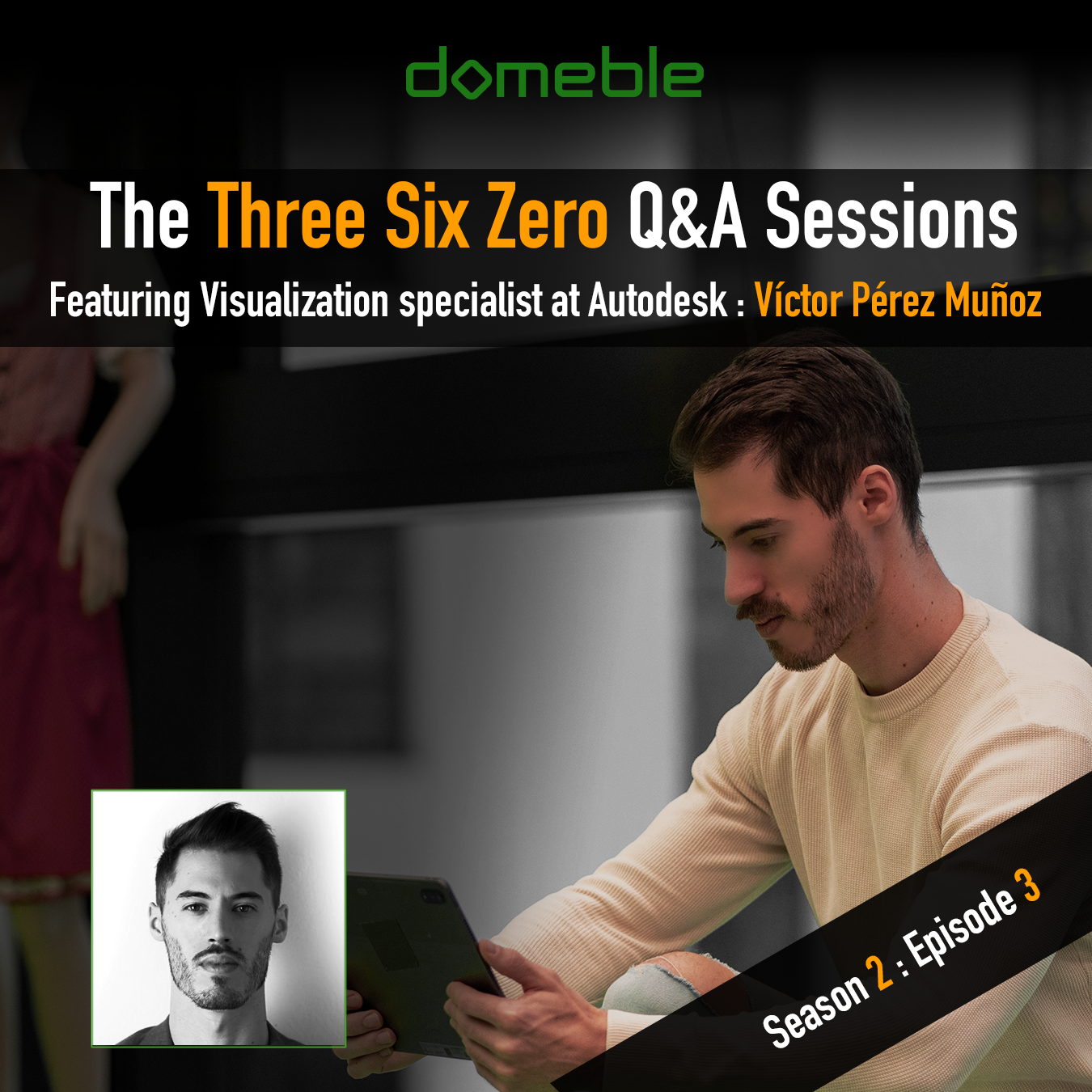In this episode of the Domeble 360 Questions, we chatted with -Víctor Pérez Muñoz Visualisation Specialist at Autodesk.
Tell us how your interest in the creative world started and how did you get into 3D?
I started engineering and modelling with Catia and Solidworks. I hated how the presentations of our work looked, and started to animate them and discovered 3DS max. I kept pushing the presentation quality until I decided to leave the mechanical engineering world and dedicate myself to 3D visualization.
How did you decide on a course in the 3D study and the uni you studied at?
My uni didn´t offer a proper 3D visualization course, it was more focused on Design methodologies. To balance this and concentrate more on what I liked, I decided to do a masters specialising in 3D modelling and real time animation. They offered a course using 3D tools such as 3DS max, Corona and Unreal engine, which was the reason why I decided on it.
What artists or 3D creators have influenced you throughout your journey so far?
Blender guru for his tutorials. Mitja Borkert, Chief of design at Lamborghini
What advice would you give to students looking to study CGI / 3D?
Many times we think technical expertise is all. Being good at 3D is important, but it’s not everything. Don´t feel overwhelmed by learning every possible software, and don’t feel bad when you see people doing things better than you. It’s not a sprint, it’s an endurance race.
What are your favourite flavours of software and what’s your workflow?
In architecture, I used to model in 3DS max and render using Corona or Unreal engine for realtime. Now, for automotive, I model in 3DS max and Alias, export to Vred and visualize the designs using Varjo or Nvidia Cloud XR.
You won gold in the 2021 Domeble Symetri Awards, and guested as a judge for the 2022 awards, how important do you think these awards are and did they help you progress with your career in 3D?
I think the exposure to the industry partners and the networking that made part of the event really helped to push me out of the bubble 3D artists live in, and helped show my work outside of it.
You recently started a new position at Autodesk, tell us a bit about the new job.
I cover Vred for the automotive visualization market within Autodesk together with my colleague Danny Tierney. We make part of the sales organization so we not only use the tools to create awesome visuals, but we also get to visit the OEMs and pitch the new features, see how they work and help them work better with our tools, and do promotional events, which I find really refreshing. We often do XR showcases using Vred, and try to push the envelope by using real-time raytracing, etc.
Real-time configurators and real-time productions are emerging and developing quicker than any of us can keep track of. Where do you see this in the 3D world over the next few years, and how does it, ( or how will it?) change your creative process?
Referring to automotive, I see it making part of the design process more and more, being further integrated with final customers, in engineering, etc. Right now visualization is a separate step in the process. I believe having a separate window where you can visualize the design in lifelike quality (In or out of VR) at any moment of the process will be the future.
Where do you see the future of rendering and HDR development?
A great part of my usage of HDRs is creating realistic lighting in a scene. I believe the future is to democratize HDRs. To not need an expensive rig to create them, but a higher quality 360 camera, and, who knows, maybe to be able to create 360 HDR video for, for example, real-time street driving simulations with realistic lighting and reflections. Combine it with photogrammetry. Blend the line between 2D images and 3D.
Let’s talk about traditional image quality and HDRI- how important is quality content and deep dynamic HDRIs as a foundation to your CGI image pipeline? ( feel free to mention Domeble.)
I think realism cannot be achieved without an HDRI. I mostly do live XR, so we usually shoot our 360s ourselves on the location and at the time of the event, so the light is as similar as possible to the final show lighting. An extreme dynamic range is needed to have accurate lighting. Without realistic lighting, even the highest quality model will look cartoony.
It’s impossible to ignore the rapid rise of AI in our industry – Game changer or hype? what are your thoughts?
I think it’s really revolutionary but, like in the first days of Autopilot, we have to take a step back and acknowledge its limitations. An AI model is as smart as the database is based on, and most importantly, cannot create anything outside of the data it’s based on. This capacity is what gives creators an edge over AI.
Its an ever-changing world, and an ever-changing industry we work in too, what do you think the industry will be like in 5 years’ time?
Less time spent on model optimization. Way more automation driven by AI (See automatic masking in Lightroom).More streaming and less local-based content
And finally, what advice would you give a young 3D artist/student just starting out on their career journey?
Keep trying, publish your jobs and don’t worry if they don´t get much attention. And especially, develop your interpersonal skills. Knowing how to sell yourself and establish meaningful relationships is often as important as being good at 3D. Be curious, and thankful for your achievements, and if you succeed stay humble and help other people to succeed as well.
For more information about Domeble,
[maxbutton id=”1″ ]










